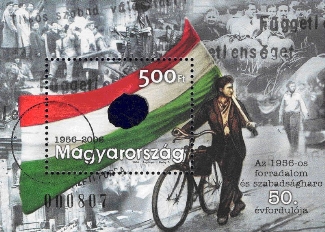IN MEMORIAM 1956
Date of issue: 20 October 2006
„On 16 October 1956, breaking with the monolithic institutional structure until then, university students in Szeged es-tablished an organisation independent of the party. They de-mocratically elected their own leaders themselves, compiled their programme and in their announcements encouraged the expansion of the organisation to the rest of the country. On their initiative student meetings were held across the nation. On 22 October students at the Budapest Technical University announced a demonstration to express solidarity with changes in Poland for the next day. On 23 October the party leadership had neither the courage nor strength to prevent the demonstration. In the afternoon workers and the people of Budapest joined the protest. A crowd of several hundred thousand gathered in Bem Square, then in front of the Parliament, where Imre Nagy’s speech was unable to pacify the crowd. After the demonstrators had demanded for hours that the Radio broadcast the students’ demands, late in the evening the police defending the building opened fire on the crowd. In response the demonstrators obtained arms and laid siege to the Radio.

Thus what had started as a peaceful demonstration turned into an armed uprising. At dawn Soviet tanks arrived in Budapest, but their appearance did not quell the movement but rather swelled the ranks of resistance: the uprising became a national war of independence. Political measures to restore order – Imre Nagy’s appointment as prime minister, and the imposition of martial law and a ban on public meetings – were ineffectual. While freedom fighters were engaged in a bitter battle in Budapest and the party leadership was immersed in unproductive disputes over how to handle the situation and what political and military measures to take, the whole country joined the movement. Revolutionary councils took over the management of factories and other workplaces, as they did the running of towns and even some counties. Demanding the creation of a democratic, independent, neutral Hungary, they provided support for those involved in the armed struggle. On 28 October Imre Nagy announced a ceasefire with Soviet approval, and at the same time also declared that several demands would be met. The most important was the disbandment of the State Security Authority and the start of negotiations on the withdrawal of Soviet troops. Internal peace, however, could only be restored after the announcement of the restitution of the multi-party system and Hungary’s neutrality. In the first few days of November the armed groups and the revolutionary bodies recognised the government, a return to work was ordered and the establishment of a force loyal to the revolution, the National Guard, began. However, by the time order had been restored in the country, Khrushchev decided to suppress the Hungarian revolution by force...”
(Source: Attila Szakolczai: The 1956 Revolution and War of Independence)
The principal motif of the design of the numbered stamp block is the Hungarian flag with a hole, a symbol of the 1956 Revolution and War of Independence, while the frame shows a montage of events of the time. A special feature of the 50th anniversary block is that there is actually a hole in the flag. The first day cover and the design of the postmark have motifs recalling events in 1956.
Order code:
2006230030011 (block)
2006230060012 (FDC)
Date of issue: 20 October 2006
Face value: HUF 500
Number of copies: 150,000
Printing method: Offset
Perforated size: 40 x 31.5 mm
Trimmed size: 89 x 65 mm
Printed by: Állami Nyomda Nyrt.
Designed by: Péter Berky

